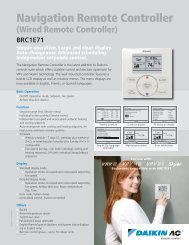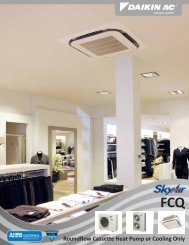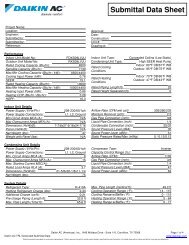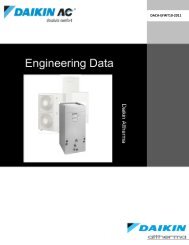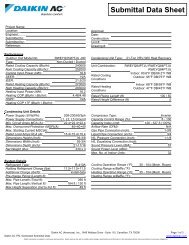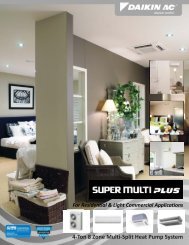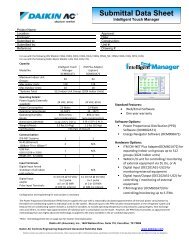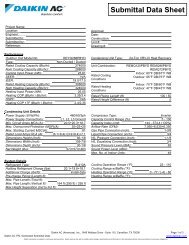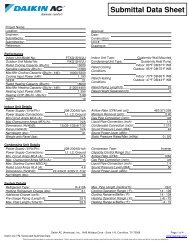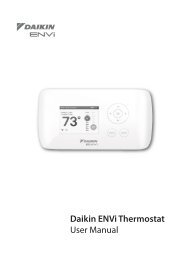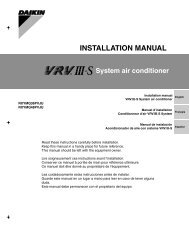INSTALLATION MANUAL - Daikin AC
INSTALLATION MANUAL - Daikin AC
INSTALLATION MANUAL - Daikin AC
Create successful ePaper yourself
Turn your PDF publications into a flip-book with our unique Google optimized e-Paper software.
Refrigerant pipework<br />
For all guidelines, instructions and specifications regarding<br />
refrigerant pipework between the indoor unit and the outdoor unit,<br />
please refer to the outdoor unit installation manual.<br />
The location of the gas pipe and liquid pipe on the indoor unit is<br />
shown under "Main components" on page 10.<br />
Refrigerant piping<br />
specifications Indoor unit Outdoor unit<br />
Gas pipe connection 5/8 inch (15.9 mm) 5/8 inch (15.9 mm)<br />
Liquid pipe connection 3/8 inch (9.5 mm) 3/8 inch (9.5 mm)<br />
When connecting the refrigerant pipes, always use two<br />
wrenches/spanners for tightening or loosening nuts! Failure<br />
to do so can result in damaged piping connections and leaks.<br />
Water pipework<br />
Checking the water circuit<br />
The units are equipped with a water inlet and water outlet for<br />
connection to a water circuit. This circuit must be provided by a<br />
licensed technician and must comply with all relevant local laws and<br />
regulations.<br />
Checking the water volume and expansion vessel prepressure<br />
The unit is equipped with an expansion vessel of 2.6 gallons (10 litre)<br />
which has a default pre-pressure of 14.5 psi (1 bar).<br />
To assure proper operation of the unit, the pre-pressure of the<br />
expansion vessel might need to be adjusted and the minimum and<br />
maximum water volume must be checked.<br />
1 Check that the total water volume in the installation, excluding<br />
the internal water volume of the indoor unit, is 5.3 gallons (20 l)<br />
minimum. Refer to "Technical specifications" on page 43 to<br />
know the internal water volume of the indoor unit.<br />
NOTE<br />
In most applications this minimum water volume will have a<br />
satisfying result.<br />
In critical processes or in rooms with a high heat load<br />
though, extra water volume might be required.<br />
When circulation in each space heating loop is<br />
controlled by remotely controlled valves, it is important<br />
that this minimum water volume is kept even if all the<br />
valves are closed.<br />
Example<br />
NOTE<br />
The unit is only to be used in a closed water system.<br />
Application in an open water circuit can lead to<br />
excessive corrosion of the water piping.<br />
1<br />
2<br />
3<br />
4<br />
5<br />
T1<br />
T2<br />
6 8<br />
T3<br />
NOTE<br />
Before continuing the installation of the unit, check the<br />
following points:<br />
■ The maximum water pressure = 43.5 psi (3 bar) +<br />
static pressure of pump.<br />
■ The maximum water temperature is 149°F (65°C)<br />
(safety device setting).<br />
■ Two shut-off valves are delivered with the unit. To<br />
facilitate service and maintenance, install one at<br />
the water inlet and one at the water outlet of the<br />
indoor unit. Mind position of the shut-off valves.<br />
Orientation of the integrated drain and fill valves is<br />
important for servicing. See figure 3.<br />
■ Drain taps must be provided at all low points of<br />
the system to permit complete drainage of the<br />
circuit during maintenance.<br />
Two drain valves integrated in the shut-off valves<br />
are provided to drain the water from the indoor<br />
unit water system.<br />
■ Make sure to provide a proper drain for the<br />
pressure relief valve to avoid any water coming<br />
into contact with electrical parts.<br />
■ Air vents must be provided at all high points of the<br />
system. The vents should be located at points<br />
which are easily accessible for servicing. An<br />
automatic air purge is provided inside the indoor<br />
unit. Check that this air purge valve is not tightened<br />
too much so that automatic release of air in the water<br />
circuit remains possible.<br />
■ Take care that the components installed in the<br />
field piping can withstand the water pressure and<br />
water temperature.<br />
■ Always use materials which are compatible with<br />
water used in the system and with the materials<br />
used on the indoor unit.<br />
■ Select piping diameter in relation to required<br />
water flow and available ESP of the pump.<br />
■ The minimum required water flow for the indoor<br />
unit operation is 4.23 gallons/min (16 l/min).<br />
When the water flow is lower than this minimum<br />
value, flow error 7H will be displayed and the<br />
operation of the indoor unit will be stopped.<br />
7<br />
FHL1<br />
FHL2<br />
FHL3<br />
1 Outdoor unit 8 By-pass valve (field<br />
2 Indoor unit<br />
supply)<br />
3 Heat exchanger FHL1..3 Floor heating loop<br />
4 Pump<br />
(field supply)<br />
5 Shut-off valve T1..3 Individual room<br />
thermostat<br />
(optional)<br />
6 Collector (field<br />
supply)<br />
7 Shut-off valve<br />
2 Using the table below, determine if the expansion vessel prepressure<br />
requires adjustment.<br />
M1<br />
M1..3<br />
M2<br />
M3<br />
Individual<br />
motorised valve to<br />
control loop FHL1<br />
(field supply)<br />
Installation manual<br />
14<br />
EKHBH/X054BA<br />
Indoor unit for air to water heat pump system<br />
4PW54216-1




